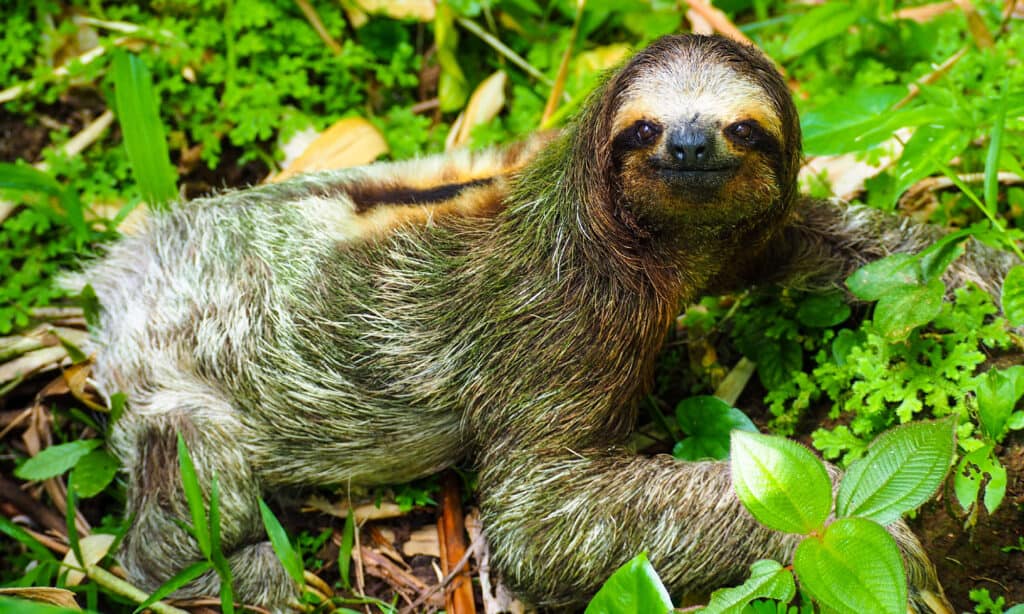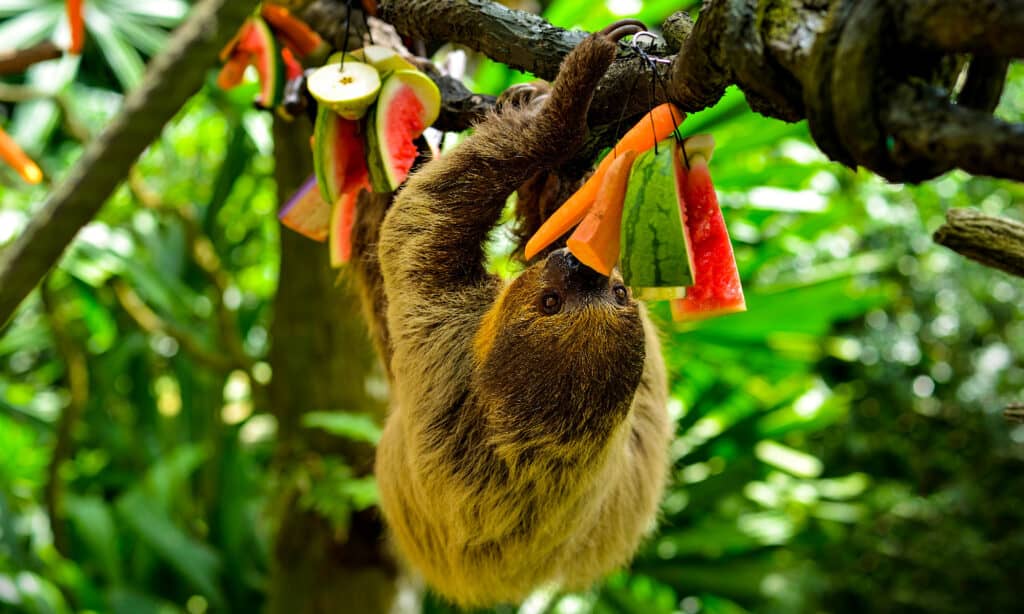The sloth is a mammal belonging to the Bradypodidae family and the genus Bradypus. Known scientifically as Choloepus hoffmani, the sloth can be found lounging in tall trees in South America and Central America.
One of the major reasons they spend most of their time on treetops is their clumsiness and tardiness while walking on the ground, which has earned them a reputation as the world’s slowest-moving mammals. They often find their way down the trees when they need to relieve themselves. In this article, we’ll be looking to provide fact-based information about sloth poop; the frequency, appearance, and what have you. Let’s get into it, shall we?
What Does Sloth Poop Look Like?
Sloths are some of the most infrequent poopers in the animal kingdom. They poop roughly once a week and their abnormal style of pooping makes it difficult for most people to see their poop. However, a super dedicated observation by some researchers revealed that sloth poop looks like brown little nuggets, with each one measuring the size of a cherry. They may also look black with greenish spots. Of course, with time, they become very hard and get all mashed up. Because of the shape and decent look, some animals around the area might even mistake it for a healthy piece of food.
Is Sloth Poop Harmful?

Not only are they harmless, sloth poops are also pretty beneficial for the moth species that live in their fur.
©jdross75/Shutterstock.com
There is no indication that sloth poops are harmful, whether to other animals or humans. While they are known carriers of some very nasty flagellates that can even affect humans, we found no evidence tying this to their poop.
For one, the style of pooping, especially adopted by three-toed sloths which involves digging a hole in the ground to poop makes it rare for anyone or animal to get exposed to their scats. Also, some moth species, who notably camp in the sloth’s fur, have, for the longest time, made a habit of laying their eggs on the pile after which the larvae feed on the decomposing excrement. So, not only are they not harmful, sloth poops are pretty beneficial for the moth species that live in their fur. However, on the off-chance that you contact or handle sloth poop, you should wash your hands thoroughly to neutralize any infections and transmission.
Speaking of harm, pooping for sloths can be a self-harming exercise for them as it involves losing about ⅕ of their body weight and getting exposed to predators. We shall speak more on this as we go on.
How Do Sloths Poop?

Sloths lose one-fifth of their body weight every time they poop.
©Sharp/Shutterstock.com
The exercise of pooping for sloths is an exciting watch and discovery for onlookers and researchers but it’s pretty daunting for the sloths. As mentioned before, sloths spend most of their time hanging around tree tops and feeding on leaves. However, their slow metabolic rate makes it so that they only poop once a week. Now, one would expect that, like other animals that live on treetops, sloths would just damn the human campers and other land animals that walk the grounds and just let it rip from the top.
Surprisingly, they do not. They instead prefer to climb all the way down to do their business. Before getting to it, sloths do some wiggling and dancing on the forest floor to create a hole for the excrement. Once they are done, they twerk their hindquarters once again to spread dirt across the hole and cover it up. Pretty hygienic, right? Well, it’s also pretty dangerous because this strenuous pooping activity exposes them to predators many times.
As a matter of fact, only 50% of sloths who climb down to poop make it back up. Not to mention, every time they poop, they lose one-fifth of their body weight, which is a lot. For perspective, imagine losing ⅕ of your current body weight every time you poop. Scary, right? Well, sloths have to deal with that all their lives.
Do Sloth Poops Smell?
Like we said before, sloth poop is very hard to come by, so it takes a lot to get near enough to smell it. Researchers and adventurers who have smelled sloth poop say it smells like “decomposing plant matter” for the most part. That’s very much credible, seeing as they are arboreal animals who mostly feed on leaves.
While it is not something you want to stay around all day, sloth poop isn’t nearly as smelly and pungent as dog poop or human poop.
How Often Do Sloths Poop?

Sloths poop once a week.
©Kristel Segeren/Shutterstock.com
As we mentioned before, one of the most interesting facts about sloths is that they only poop once a week. They are generally slow animals that deal with a slow metabolism, which is why they do not poop until about a week after their last pooping session. While that sounds like one hell of a predicament, (and it is), every time a sloth poops, there is a 50% chance it doesn’t make it back. Scientists also say they lose ⅕ of their weight every time they poop. Now, imagine if they had to poop every day.
Where Do Sloths Poop?
Unlike monkeys and other arboreal animals, sloths do not let their scats fly from the treetops. They typically climb down their trees and do a little dance at the base of the trees to create a hole where the droppings go, and while that’s stressful and dangerous for sloths, it’s good news for campers and adventurers.
What Do Sloths Eat?

Sloths eat plants and small animals like lizards and insects.
©tristan tan/Shutterstock.com
Since they spend most of their time lounging in trees, three-toed sloths feed on leaves, especially ones from the cecropia tree, making them predominantly herbivorous. Two-toed sloths, on the other hand, are omnivores, as they feed on plants, as well as small animals like lizards and insects.
They have a very “slothful” digestion rate, and proper digestion can take anywhere from a week to a month. Also, their meals are not packed with enough nutrients and scientists believe these not-so-nutritious meals are major contributors to their slowness and dearth of energy.
Up Next:
- 10 Incredible Sloth Facts
- Sloth Lifespan: How Long Do Sloths Live?
- Sloth vs Koala: What Are the Differences?
The photo featured at the top of this post is © Sharp/Shutterstock.com
Sources
- Sci ELO Brazil / Accessed September 9, 2022
- howstuffworks / Accessed September 9, 2022
- Livescience / Accessed September 9, 2022
Thank you for reading! Have some feedback for us? Contact the AZ Animals editorial team.







